What is Mobile?
The dictionary definition of Mobile is “movable or easily moved” but what it means to a mine operator with respect to crushing systems varies almost as much as the materials that are extracted.
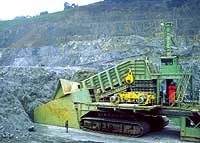 |
|
Fig1 - 4000TPH Fully Mobile Sizing Station with in ground hopper |
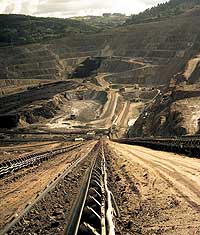 |
|
Fig2 - Lignite mine in Northern Spain |
One of the first mobile systems supplied by the MMD Group of Companies was to a Lignite operation in northern Spain. The existing mobile crusher, handling overburden, employed in the mine was a 1,000 tonne per hour Gyratory unit with a separate Truck Bridge. These units were moved using a 600 tonne capacity tracked transporter and each unit took approximately 3 days to relocate to the next level down (approximately 20 metres).
The MMD unit based on the apron plate feeder incorporating the then revolutionary in ground hopper design (fig. 1) and the 1150 Centres Twin Shaft Sizer was purchased to handle 2,000 tonnes per hour of overburden which includes clay, schist, sand and granite. This system allows dump trucks to tip directly over the mine face onto the apron plate feeder, and proved after some minor modifications to be capable of 4000 tonnes per hour.
Both units where fed by dump trucks with up to 150 tonne capacity and discharged on to a field conveyor system out of the mine (fig. 2). Due to the success of the MMD unit which was originally positioned at the top of the mine, the operators decided to swap the positions of the two crushers. Relocating the MMD as the primary unit at the bottom of the pit where it could be used on all the materials including clay which had to be removed from the mine.
The mine allowed 3 days for the relocation of the MMD unit base on the normal creep speed of the transporter, but due to the low centre of gravity and all up weight of only 350 tonnes they found that the they could travel at the top speed of the transporter. This enabled them to travel the 1.5 km down to the bottom of the mine in one day. After this first move the unit has been regularly moved as the mine level has been lowered.
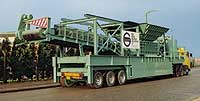 |
| Fig 3 - Typical MMD Wheeled Unit |
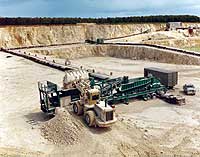 |
|
Fig 4 - MMD Wheeled unit in operation sizing hard chalk |
In contrast we supplied a series of wheeled units to a Lime processing plant based in South Yorkshire to replace Feeder Breakers which had been operating for 5 years. The hard chalk is blasted on a daily basis and loaded into the crushers using Cat 988 sized wheel loaders. We first supplied a Primary wheeled unit based on a 750 Series Sizer fitted with 4 tooth Rotors (fig 3). The method of operation at that time was to work on two levels one in the winter and a lower level in the summer due to the level of the water table at the Quarry. To achieve this they used a series of fixed and quick assembly belt units, which were erected in advance of the breaking units so that the change from one location to the next only required the minimum disruption to production. The second wheeled unit, which was based on a chain feeder and a 500 Series Sizer to produce 150mm, also fitted with 4 tooth rotors, was purchased to replace one of the Breaker Feeders which had been converted into a feeder by removing the breaking rotor. This unit also replaced one of the existing secondary crusher located after the main screening unit in the Quarry. The Primary Unit was loaded directly with the front end loaders as shown in (fig 4), and the discharge conveyor feeds the chain feeder of the second unit which takes the surges out of the system. This 500 Series Sizer is suspended above the field conveyor which takes the material to the main screening plant in the quarry. The complete system was moved every 3 – 4 months depending on the weather and the production requirements. Later the operator decided to provide a greater level of security and to allow them to open up a new area of reserves without affecting the production by purchasing a repeat of the first complete set up. The latest development has been the purchase of a track mount MMD unit based on 1000 Series Sizer fitted with 3 tooth rotors, which can handle the bigger harder lumps encountered in the bottom level of the quarry. A 625 Series Secondary fitted with 5 tooth rotors produces 125mm. These units where purchased to accommodate a planned increase in production up to 1,000 tonnes per hour which would require a new field conveyor system. This method of operation has been developed over a number of years and appears to serve the operators very well.
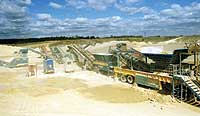 |
| Fig 5 - Fully mobile processing plant south of Lincoln |
Whilst the above units could be described as mobile they are linked to a fixed conveyor system. In contrast a Quarry based south of Lincoln have developed over a number of years a “fully” mobile processing plant. The material is Oolitic limestone in a shallow bed which contains a high percentage of fines. A hydraulic backhoe is used to win the material without blasting which reduces the amount of fines produced at the face. Their definition of mobile means the complete plant can be relocated within the quarry in One day. There are a number of Key features which make this possible. The primary Unit is a wheel mounted 750 Unit fitted with 3 tooth rotors and powered by a diesel engine which is not unusual where the mains power supply is limited. This unit is fed directly from the face by a wheel loader at approximately 500 tonnes per hour. What happens after this unit is what makes this plant so different. Both the secondary and tertiary machines, which are 500 series sizers, are mounted directly on wheel mounted screening units.(fig 5) The secondary takes the discharge directly from the primary and reduces it down to approximately 125 mm which is the top size that is supplied from the Quarry. The screen gives three products depending on the meshes which are fitted and largest can be delivered to the tertiary sizer which produces a 40mm product which is also split into three products by the screen it is mounted on. These two sizers are powered by a diesel generator whilst the screens and belts are diesel powered giving a completely independent system.
 |
|
Fig 6 - Latest limestone mobilesizing unit |
The most recent mobile unit we have supplied is to a limestone quarry in Spain with a deposit in a hillside which means they have a high multi bench system. Material is pushed from the higher bench levels to the bottom bench. The track mounted 3 tooth 750 Sizer is electric powered but the hydraulic track system is driven by a diesel engine giving the most economic operating method whilst allowing complete freedom of movement (fig 6). The unit is directly loaded by front end shovel and discharges on to two fully mobile conveyors capable of handling up to 2000 tonnes per hour. The plan is to move the Sizer Unit every 3 or 4 months and purchase extra conveyors when necessary. The material is transport to primary stockpile, which will make the rest of the processing plant independent of the primary operation allowing it to be run according to market demands.
 |
|
Fig 7 - 10,000 TPH Fully Mobile Slewing Sizer Station |
What of the future? We have designed and built a fully mobile unit, which has a design capacity of 10,000 tonnes per hour with an approximate weight of 1,500 tonnes. It combines a apron plate feeder, sizer and slewing elevating discharge conveyor mounted on a turn table. The whole unit is mounted on tracks, which allow the unit to move in conjunction with the large rope shovel feeding the unit (fig 7). This unit is to replace a bucket wheel excavator and will discharge on to an existing belt conveyor system.
Maybe from the above, an alternative definition of ‘Mobile’ is more accurate, mobile meaning ‘not fixed’.
Source: http://www.mmdsizers.com/news/articles/mobile.php

|